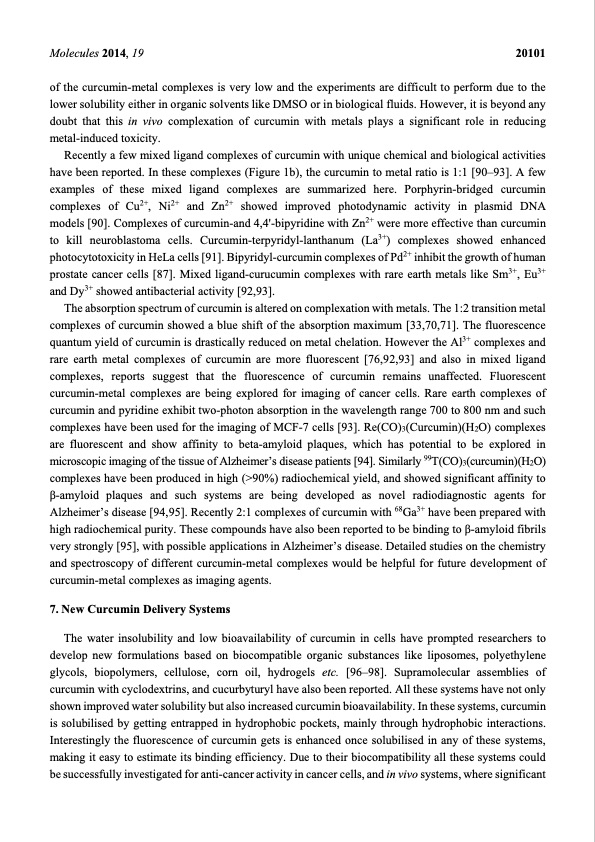
PDF Publication Title:
Text from PDF Page: 011
Molecules 2014, 19 20101 of the curcumin-metal complexes is very low and the experiments are difficult to perform due to the lower solubility either in organic solvents like DMSO or in biological fluids. However, it is beyond any doubt that this in vivo complexation of curcumin with metals plays a significant role in reducing metal-induced toxicity. Recently a few mixed ligand complexes of curcumin with unique chemical and biological activities have been reported. In these complexes (Figure 1b), the curcumin to metal ratio is 1:1 [90–93]. A few examples of these mixed ligand complexes are summarized here. Porphyrin-bridged curcumin complexes of Cu2+, Ni2+ and Zn2+ showed improved photodynamic activity in plasmid DNA models [90]. Complexes of curcumin-and 4,4'-bipyridine with Zn2+ were more effective than curcumin to kill neuroblastoma cells. Curcumin-terpyridyl-lanthanum (La3+) complexes showed enhanced photocytotoxicity in HeLa cells [91]. Bipyridyl-curcumin complexes of Pd2+ inhibit the growth of human prostate cancer cells [87]. Mixed ligand-curucumin complexes with rare earth metals like Sm3+, Eu3+ and Dy3+ showed antibacterial activity [92,93]. The absorption spectrum of curcumin is altered on complexation with metals. The 1:2 transition metal complexes of curcumin showed a blue shift of the absorption maximum [33,70,71]. The fluorescence quantum yield of curcumin is drastically reduced on metal chelation. However the Al3+ complexes and rare earth metal complexes of curcumin are more fluorescent [76,92,93] and also in mixed ligand complexes, reports suggest that the fluorescence of curcumin remains unaffected. Fluorescent curcumin-metal complexes are being explored for imaging of cancer cells. Rare earth complexes of curcumin and pyridine exhibit two-photon absorption in the wavelength range 700 to 800 nm and such complexes have been used for the imaging of MCF-7 cells [93]. Re(CO)3(Curcumin)(H2O) complexes are fluorescent and show affinity to beta-amyloid plaques, which has potential to be explored in microscopic imaging of the tissue of Alzheimer’s disease patients [94]. Similarly 99T(CO)3(curcumin)(H2O) complexes have been produced in high (>90%) radiochemical yield, and showed significant affinity to β-amyloid plaques and such systems are being developed as novel radiodiagnostic agents for Alzheimer’s disease [94,95]. Recently 2:1 complexes of curcumin with 68Ga3+ have been prepared with high radiochemical purity. These compounds have also been reported to be binding to β-amyloid fibrils very strongly [95], with possible applications in Alzheimer’s disease. Detailed studies on the chemistry and spectroscopy of different curcumin-metal complexes would be helpful for future development of curcumin-metal complexes as imaging agents. 7. New Curcumin Delivery Systems The water insolubility and low bioavailability of curcumin in cells have prompted researchers to develop new formulations based on biocompatible organic substances like liposomes, polyethylene glycols, biopolymers, cellulose, corn oil, hydrogels etc. [96–98]. Supramolecular assemblies of curcumin with cyclodextrins, and cucurbyturyl have also been reported. All these systems have not only shown improved water solubility but also increased curcumin bioavailability. In these systems, curcumin is solubilised by getting entrapped in hydrophobic pockets, mainly through hydrophobic interactions. Interestingly the fluorescence of curcumin gets is enhanced once solubilised in any of these systems, making it easy to estimate its binding efficiency. Due to their biocompatibility all these systems could be successfully investigated for anti-cancer activity in cancer cells, and in vivo systems, where significantPDF Image | Curcumin: From Extraction to Therapeutic Agent

PDF Search Title:
Curcumin: From Extraction to Therapeutic AgentOriginal File Name Searched:
molecules-19-20091.pdfDIY PDF Search: Google It | Yahoo | Bing
CO2 Organic Rankine Cycle Experimenter Platform The supercritical CO2 phase change system is both a heat pump and organic rankine cycle which can be used for those purposes and as a supercritical extractor for advanced subcritical and supercritical extraction technology. Uses include producing nanoparticles, precious metal CO2 extraction, lithium battery recycling, and other applications... More Info
Heat Pumps CO2 ORC Heat Pump System Platform More Info
| CONTACT TEL: 608-238-6001 Email: greg@infinityturbine.com | RSS | AMP |